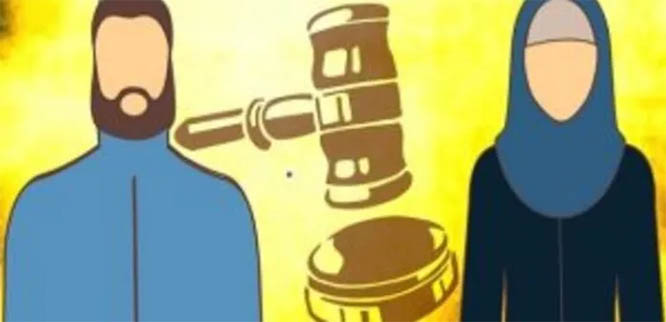
The Supreme Court today (July 10, 2024) held that a Muslim woman is entitled to file a petition for maintenance against her husband under Section 125 of the Code of Criminal Procedure.
The Bench of Justices BV Nagarathna and Augustine George Masih dismissed a petition filed by a Muslim man's plea against the direction to pay interim maintenance to his divorced wife under Section 125 CrPC. The Court held that the Muslim Women (Protection of Rights on Divorce) Act 1986 will not prevail over the secular law.
Justices Nagarathna and Masih delivered separate but concurring judgments.
"We are dismissing the criminal appeal with the conclusion that Section 125 CrPC would be applicable to all women and not just married women," Justice Nagarathna stated.
The bench clarified that if during the pendency of a petition under Section 125 of the CrPC a Muslim woman is divorced, then she can take recourse to the Muslim Women(Protection of Rights on Marriage) Act 2019. The bench stated that the remedy under the 2019 Act is in addition to the remedy under Section 125 CrPC.
Background
For a comprehensive understanding of the facts of the case and the issue involved, click here.
Senior Advocate S Wasim A Qadri, appearing for the petitioner-husband, raised the following contentions:
(A) The Muslim Women (Protection of Rights on Divorce) Act, 1986 Act ("Act") is a special law in the nature of beneficial legislation, which provides way more than what Section 125 CrPC contemplates. Besides maintenance, Section 3 of the Act also deals with mehr, dower and return of property. Under the Act, a "reasonable and fair" provision is also made for the divorced woman's entire life, but the same is not contemplated under Section 125 CrPC. Moreover, if the divorced woman has sufficient means, she cannot file for maintenance under Section 125 CrPC, however, that is the case with Section 3 of the Act.
(B) To the legal position flowing from Mohd Ahmed Khan v. Shah Bano Begum, factum of divorce was not relevant and every Muslim woman was entitled to maintain a Section 125 CrPC petition. To upset this ruling, the Act was enacted and it codified the Supreme Court judgment. The Act is a complete code in itself and a reading of its provisions would show that it was intended to have an overriding effect over Section 125 CrPC. While it makes provisions for "divorced" Muslim women, deserted or neglected Muslim women may resort to Section 125 CrPC.
(C) It is a settled position of law that special law (the Act) shall prevail over general law (CrPC). Language of the Act being clear, there is no reason for the Court to go beyond. It must simply give effect to what is stated in the Act.
(D) Section 5 gives an option to the divorced couple to not be governed by the Act. This shows that a Muslim wife cannot resort to both remedies.
(E) As per Section 7 of the Act, a Section 125 CrPC petition pending at the time of commencement of the Act was to be disposed of by the Magistrate in terms of Section 3 of the Act. This shows that the ambit of Section 125 CrPC in these petitions was to be interpreted in light of provisions of the Act, read with Section 5 CrPC (which excludes applicability of CrPC provisions when there is a special provision).
(F) Under doctrine of implied repeal, the Parliament is presumed to know pre-existing law and won't intend to create any confusion by retaining conflicting provisions. In applying this doctrine, Court must give effect to legislative intent of the two enactments (CrPC and the Act).
Amicus and Senior Advocate Gaurav Agarwal, on the other hand, put forth the following submissions:
(A) The Act only concretizes Muslim personal law. It broadens a divorced Muslim woman's entitlement to maintenance beyond the iddat period, but does not take away the relief available to her under Section 125 CrPC because the purpose behind the latter is different.
(B) The petitioner's reliance on Section 5 of the Act is misplaced, as that provision comes into play when an application has been filed under Section 3 of the Act. In the present case, the respondent-wife had approached the Court under Section 125 CrPC.
(C) Section 7 of the Act is only a transitional provision. If an application was pending under Section 125 CrPC on the date of commencement of the Act, it was to be subsequently governed by Section 3. However, that does not mean that Section 125 CrPC petitions could no longer be filed.
(D) In Danial Latifi & Anr v. Union Of India, Supreme Court only dealt with validity of the Act. Though the validity of provisions of the Act was upheld, the Bench questioned in the said case as to how it could deprive Muslim divorced women the same right which is available to other women in the country.
(E) As per Section 127(3)(b) CrPC, if some provision has been made under personal law, a husband may avoid liability for maintenance under Section 125 CrPC. It would be for Courts to record a fact-finding in this regard.
(F) Different High Courts have taken different views, so clarity on the issue has become necessary. Judgments that are no longer good law may be declared as such. Kerala High Court has taken a view both Section 125 (CrPC) petition and Section 3 (1986 Act) petition are maintainable, but a woman has to choose between one of the two. But this position is not correct.
Before conclusion of arguments, the Amicus also pointed to a scenario where a divorced Muslim woman may accept provision made under personal law for her entire life, but later realize that it was not sufficient. In that case, she can only approach under Section 125 CrPC and not under Section 3 of the Act. As such, she should not have to choose between the two remedies and must be entitled to both.
Court Observations during the hearing
During the hearing, the Bench remarked that Section 3 of the Act begins with a non-obstante clause. As such, it is not in derogation to what is already provided under Section 125 CrPC, but an additional remedy.
Justice Masih said : "this Act does not bar...it is the choice of the person who had applied or moved an application under 125...there is no statutory provision provided under the Act of 1986 which says that 125 is not maintainable". Concurring, Justice Nagarathna said that there was nothing in the 1986 law which barred one remedy in favor of the other.
When the Bench enquired as to whether the present petitioner had paid anything to the respondent-wife during the iddat period, answer was given in the negative. The Amicus clarified that a draft of Rs.15,000 was tendered by the petitioner during the iddat period, but the same was not claimed by the respondent-wife. Taking into account the same, the Bench said that it would still have been understandable if the petitioner had made provision for the wife during the iddat period, as in that case, Section 127(3)(b) CrPC may have come into play.
Responding to the petitioner's submission that none of the judgments cited by either side had dealt with Section 7 of the Act, Nagarathna J said that the provision was only with regard to pending cases (and thus, transitory). Countering the contention, the Amicus drew attention of the Court to a Kerala High Court judgment which considered Section 7 and held that it could not be interpreted as extinguishing the right of divorced Muslim women to file petitions under Section 125 CrPC.
Notably, the Kerala High Court (in the judgment cited by the Amicus) was of the view that the transitory provision was intended to do away with the necessity of Muslim women, who had Section 125 CrPC petitions pending at the time of commencement of the Act, having to file fresh claims under Section 3 of the special law. To quote the Bench,
"If the Parliament had the intention to extinguish such rights of the Muslim woman, it would only be reasonable to expect the Parliament to speak in definite and specific language about such extinguishment. Parliament must have been aware that when 1986 Act was enacted, number of orders must have passed in favor of divorced Muslim women under Section 125...Message appears to us to be loud and clear...Both rights, under Section 125 of the Code and Section 3 were conferred on the divorced women. She has the right to choose."
As against the petitioner's submission that the provisions of the Act indicate Parliament's intent to bar entitlement of Muslim women to file maintenance claims under Section 125 CrPC, the Court expressed an opinion that the same would be unconstitutional.
If the Parliament intended for divorced Muslim women to no longer be entitled to file petitions under Section 125 CrPC from the date of commencement of the Act, it could have explicitly given an overriding effect to the Act, the Bench remarked. To quote Nagarathna J, "In the absence of such a thing, can we add a restriction to the Act? That is the point".
After hearing the submissions of both the Senior Advocates, the judgment was reserved on February 19.
Counsels for petitioner-husband: Senior Advocate S Wasim A Qadri; Advocates Saeed Qadri, Saahil Gupta, Deepak Bhati and Shivendra Singh; AOR Udita Singh






Comments
Add new comment